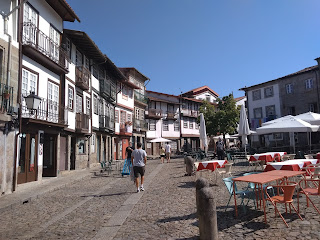Of Galicia's seven cities, three of them have airports. That's a lot of airports for just one Autonomous Community with no city over 500,000 residents. On the southern coast is Vigo, which makes sense because it is a major port city with industry. Then there's Santiago de Compostela, perhaps Galicia's biggest airport. Aside from being centrally located, it's also the capital, so that also makes sense. Then on the northern coast is A Coruña, home to the fashion industry of Inditex. Basically each city has their reasons for having an airport of their own.
But one consequence of Galicia's multiple airports is that there is no single hub for international flights. Because of this, to fly internationally (to outside of the EU especially) it is often cheaper and quicker to fly from the Northern Portuguese city of O Porto. Depending on which part of Galicia you're coming from, it can be only two or three hours away. (Factoring in the time zone change to one hour behind, you can ¨get there¨ in as little as one hour!) That's much quicker than driving to Spain's central airport in Madrid, at least five hours away from Galicia. So thanks to the flight from Portugal, this year before my well-overdue trip home we spent a full week in Northern Portugal.
 |
| Castle of Guimarães |
 |
| Paço dos Duques courtyard |
 |
| The square where we had coffee, with its Medieval monument |

We couldn't fill up on sweets, though, as lunch was right around the corner! Well, I was convinced that the Portuguese eat lunch way earlier than the Spanish do (here it's usually around 2 or 3 PM). I guess I exaggerated but all the better. That way we beat the rush and didn't have to wait. We ate in an old manor house turned-restaurant, with the huge, shady courtyard used as the terrace. In addition to pastries, Portugal is also known for its many ways of preparing cod. And so the Cod Fest commenced! Not for me, of course. Not a huge fish fan. But someone else may have challenged himself to eat cod everyday.
After lunch we visited the castle and paço. No waiting at lunchtime. Then we skedaddled south, to spend a few nights camping...